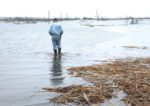Advertise Follow Us
Articles Tagged with ''mycorrhizae''
Renowned soil scientist Jill Clapperton explains how certain cover-crop species and other management practices can help resolve tough no-till problems.
Read More
20 Ways To Build Better No-Till Soils
World-renowned soil scientist and Rhizoterra co-founder Jill Clapperton shares tips and insights about no-tilled soils that could help growers lower their productivity costs and increase yields.
Read More
Picking A Strategy For Unplanted Fields
Experts say cover crops are the best option for no-tillers to suppress weeds, and boost nutrient levels and soil microbial activity ahead of next year’s planting.
Read More
Soil Fungi Are The Root Of All Yields
Invisible to the naked eye, soil fungi bring nutrients and water to roots and fend off disease, too
Read More
Let The “Living Soil” Boost Your No-Till Returns
Use the additional worms, nematodes, bacteria and other microorganisms found in no-tilled fields to expand your profits.
Read More









